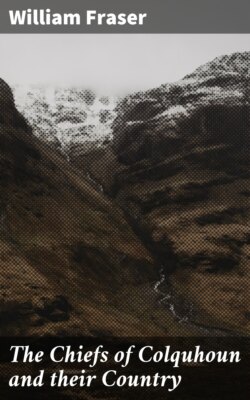Table of Contents
Sir John of Luss, Knight, succeeded Maurice, and seems to have been his son. He was high in favour with Malcolm fifth Earl of Lennox, in whose house he bore the office of Usher (Bacularius). From that Earl he obtained grants of several remarkable privileges made by a charter, which is without date, but which was confirmed by King Robert the Bruce on the 6th of March 1315. By this charter Earl Malcolm, “for the reverence and honour of our patron, the most holy man, the blessed Kessog,”[1] renounced in favour of Sir John of Luss, “our beloved and faithful bacularius,” and his heirs, all right which belonged to the earls of Lennox, as superiors of the estate of Luss, of services, captions, or services of carriage within these lands. He further exempted Sir John and his vassals within or without the bounds of the said lands from being called upon by the bailies or servants of the King’s Justiciary, or by the bailies or servants of the earls of Lennox, to appear and give testimony as witnesses either in the courts of the King, or in those of the earldom of Lennox, engaging that he himself and his heirs should be always prepared to find sufficient witnesses from other men of his earldom, as often as it should be necessary, that the service of the King might not seem to miscarry from any defect on their part in producing witnesses.[2] Earl Malcolm also granted to Sir John the homage and service, forinsic and intrinsic, due to the earl from the lands of Banwrith [Banry or Bandry, which is opposite the islands mentioned], together with the islands of Innesconogaig and Elanclew, as possessed by Maldofen Macgillemychelmore and his heirs, and Gilchrist Maccristyne and his heirs, to be held by the said Sir John for rendering for the King’s common army two cheeses, and for the assistance of the King as much service as belongs to such an extent of land.[3]
On 6th March 1316 the charter granted by Maldouen third Earl of Lennox to Gillemore, son of Maldouen, Dean of Luss, already mentioned, was confirmed by King Robert the Bruce in favour of Sir John of Luss.[4] Sir John is mentioned in several charters granted during his lifetime to his son Malcolm by Malcolm fifth Earl of Lennox.[5] He was witness to a charter by Malcolm Earl of Lennox to Christian and Margaret Drummond, daughters of John Drummond, of the lands of Ardeureane and Ardenalochreth. He was a witness to another charter by Thomas de Cremmenane to Murechanich, son of Kork, of a quarter of the land of Croyne, and to a confirmation of that charter by Malcolm fifth Earl of Lennox. In all these charters he is designated “Johannes de Luss, miles.”[6]
Sir John had issue, apparently two sons,—
1.
Malcolm, who succeeded him.
2.
Duncan. Duncan of Luss is usually mentioned as the sixth Laird of this family, as if he had been the son of Malcolm and grandson of Sir John. There is, however, no evidence of his filiation, and he was more probably a younger son of Sir John, or if he was the eldest son he must have predeceased his father. The generations would otherwise be too numerous. Besides, the only lands which we know of his possessing were those of Kilfassane and Ballindalach, in the earldom of Lennox, and those of Auchmar, in the shire of Dumbarton.[7] He was a witness to a charter by Malcolm Earl of Lennox to Patrick Galbraith of a half-quarter of the lands of Camkell, and to another by the same Earl to Gillemore, son of Maliseus Bane, of the lands of Blarechos, in Strablane.[8] In both these charters he is designated “Duncanus de Luss.” The charters are without date, but they could not have been later than the year 1333, the granter having fallen in the battle of Halidonhill, fought 19th July that year. Duncan was forfeited in the reign of King David the Second, but for what reason does not appear. His lands of Kilfassane and Ballindalach were granted by a charter, in which they are said to have formerly belonged to “Duncan of Luss,” by Malcolm Fleming, first Earl of Wygtone, to Andrew of Cunninghame.[9] The charter is without date, but it must have been granted between the 9th November 1342, when Sir Malcolm Fleming was created Earl of Wigton, and 1362, when he died. And, in the year 1366, the lands of Auchmar, in the shire of Dumbarton, which had belonged to Duncan of Luss, and which, on account of his forfeiture, had fallen into the hands of the Crown, were granted by a charter by King David the Second to William Boyd.[10]
| [1] | St. Kessog, the patron saint of the parish of Luss. |
| [2] | Cartularium Comitatus de Levenax, pp. 21, 22. |
| [7] | Ibid. p. 67; Robertson’s Index, p. 68, No. 7. |
| [8] | Cartularium Comitatus de Levenax, pp. 32, 48. |
| [10] | Robertson’s Index, p. 68, No. 7, and p. 83, No. 182. |
